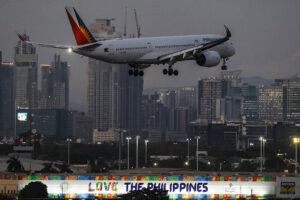By Ashley Erika O. Jose, Reporter
LOCAL AIRLINES anticipate an increase in passenger volume, following the reduction of fuel surcharges on airfares in September.
In an advisory on Wednesday, the Civil Aeronautics Board (CAB) downgraded fuel surcharge, which is added to the base fare, to Level 5 for Sept. 1-30 from Level 6 in August.
“Airlines wishing to impose or collect fuel surcharge for the same period must file their application with this office on or before the effectivity period, with fuel surcharge rates not exceeding the above-stated level,” CAB Executive Director Carmelo L. Arcilla said in an advisory.
At Level 5, the fuel surcharge for domestic flights ranges from P151 to P542.
For international flights, the fuel surcharge varies from P498 to P3,703.
A fuel surcharge may be collected by airlines based on movements in jet fuel prices, using a benchmark known as MOPS (Mean of Platts Singapore). CAB said the applicable conversion rate for September is P58.29 to a dollar.
In August, the fuel surcharge was at Level 6. For domestic flights, it ranged from P185 to P665, while the surcharge for international flights ranged from P610 to P4,538.
Cebu Pacific President and Chief Commercial Officer Alexander G. Lao said the CAB’s decision to lower the fuel surcharge is “a positive development that supports our efforts to offer more affordable travel options.”
“We look forward to carrying more passengers as we continue to boost connectivity across all our hubs,” he said in a Viber message on Wednesday.
For the second quarter alone, Cebu Pacific said it carried a total of six million passengers. The budget carrier’s highest passenger count in a single quarter, the company said.
AirAsia Philippines Communications and Public Affairs Head Steve F. Dailisan said the lower fuel surcharge for September will heavily influence air travelers’ booking decisions.
With the implementation of lower surcharge, domestic passengers will see a reduction of P542 and P800 for international passengers, Mr. Dailisan said.
“Filipinos are always on the lookout for discounts. Any budget saved from airfares can be used as an additional budget for hotels, restaurants, activities, or souvenirs,” he said in a Viber message.
The low-cost carrier has flown more than five million passengers to date, AirAsia Philippines said, adding that with the current trend the airline is expecting to end the year with eight million passenger numbers.
In an earlier statement, Philippine Airlines President and Chief Operating Officer Stanley K. Ng said the company is on track to see a 20% rise in passenger numbers across its network by yearend.
According to PAL Holdings, Inc., the operator of Philippine Airlines, the company saw its passenger volume increase by 13% or a total of 7.9 million passengers in the first semester.
Data from CAB showed that air passenger volume increased by 25.6% to 29.52 million in the first semester from 23.5 million a year ago. Of this, 15.77 million were domestic passengers, while 13.75 were international passengers.
Meanwhile, the International Air Transport Association (IATA), a trade association of the world’s airlines, said crude oil prices will remain volatile for the rest of the year.
According to IATA’s jet fuel price monitor, jet fuel prices rose by 2.9% week on week to $95.91 per barrel as of Aug. 16. Year on year, jet fuel prices declined by an average of 14.6%.
Rodela I. Romero, assistant director of the Energy department’s Oil Industry Management Bureau, said in a Viber message that prices of kerosene, which is the base of jet fuel, are estimated to increase in the next three months.
MOPS, which is used as a benchmark of the country’s local oil industry, will continue to be influenced by geopolitical conflicts and the production cuts by Organization of the Petroleum Exporting Countries and its allies (OPEC+).
